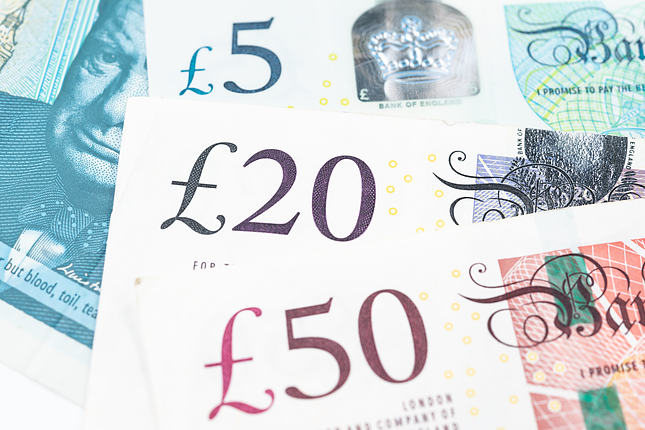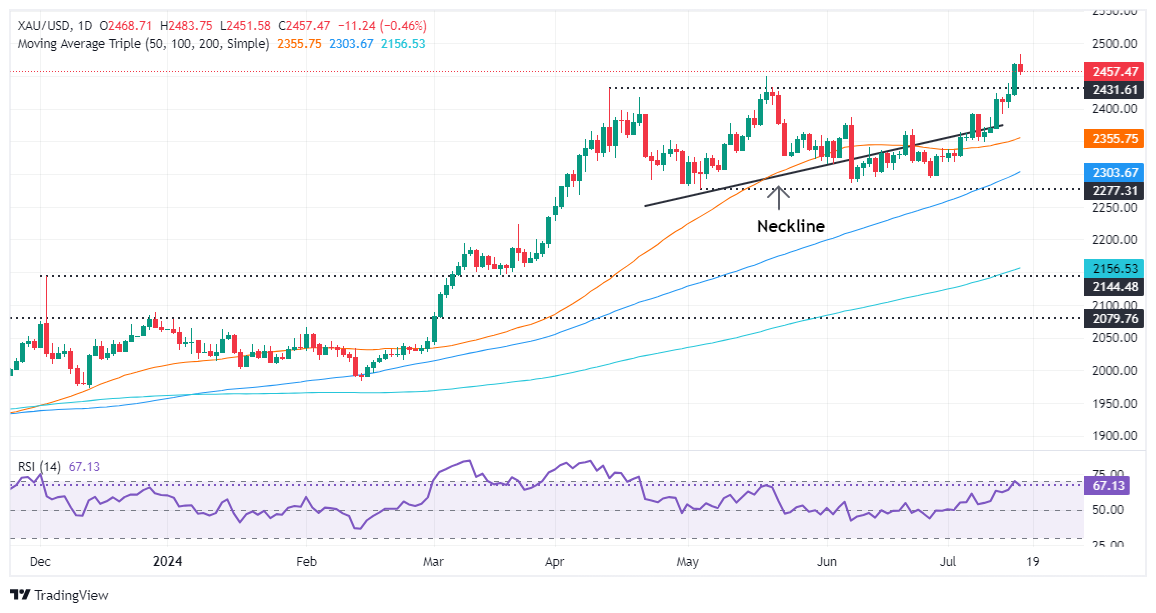- Gold prices fall to $2,457 after hitting an all-time high of $2,483 due to profit-taking.
- Fed officials signal potential rate cuts; Governor Waller suggests downward trend for Fed funds rate.
- US Dollar Index drops to 103.72, its lowest since March 2024, while US Treasury yields decline.
Gold prices retreated as investors took profits after the yellow metal rallied to an all-time high of $2,483 earlier during the North American session on expectations that the Federal Reserve would lower borrowing costs. At the time of writing, the XAU/USD trades at $2457, down more than 0.40%.
Federal Reserve officials, led by Governor Christopher Waller, crossed the wires on Wednesday. He said the time to cut the policy rate is approaching, suggesting that the most likely direction for the Fed funds rate is downwards.
Earlier, Richmond Fed President Thomas Barkin mentioned that inflation has decreased over the last quarter, acknowledging that the current policy is restrictive. However, he is open to the possibility that the policy "is not as restrictive as thought."
Meanwhile, US housing data fared better than expected in June, hinting the economy remains solid. Building Permits and Housing Starts improved compared to May, while Industrial Production decelerated but exceeded estimates.
The non-yielding metal's last leg-up was also driven by former President Donald Trump's comments, in which he favors tax reductions, lower interest rates, and increased tariffs. These would likely be inflationary for the economy and weaken the Greenback.
The US Dollar Index, which tracks the performance of the currency against other six, sinks some 0.49% at 103.72, its lowest level since March 21, 2024. US Treasury bond yields are also falling across the yield curve, with the 10-year Treasury note yielding 4.14%, down almost one and a half basis point (bps).
Daily digest market movers: Gold retreats as buyers take a breather close to $2,500
- Weaker-than-expected US Consumer Price Index (CPI) data sponsored Gold’s leg-up above $2,400, as the odds for Fed rate cuts increased, as reflected by falling US Treasury bond yields.
- The US economic calendar featured Building Permits for June, which increased by 3.4% from 1.3999 million to 1.446 million. Further housing data showed that Housing Starts for the same period expanded by 3% from 1.314 million to 1.353 million.
- US Industrial Production in June decelerated from 0.9% in May to 0.6% month-over-month (MoM) yet exceeded estimates for a 0.3% increase.
- December 2024 fed funds rate futures contract implies that the Fed will ease policy by 52 basis points (bps) toward the end of the year, up from 50 last Friday.
- Bullion prices retreated slightly due to the People's Bank of China (PBoC) decision to halt gold purchases in June, as it did in May. By the end of June, China held 72.80 million troy ounces of the precious metal.
Gold technical analysis: XAU/USD retreats below $2,460 as buyers take a breather
Gold’s uptrend is set to continue, though buyers are taking a respite after hitting all-time highs shy of $2,490. Momentum is still in their favor, as shown by the Relative Strength Index (RSI), which dipped slightly but is still bullish.
If XAUUSD resumes its uptrend, the first resistance will be the all-time high at $2,483. A breach of the latter will expose the $2,490 figure, followed by the $2,500 psychological level.
On the flip side, If XAU/USD drops below $2,450, the first support would be the $2,400 figure, followed by the July 5 high at $2,392. If cleared, Gold would extend its losses to $2,350.
Gold FAQs
Gold has played a key role in human’s history as it has been widely used as a store of value and medium of exchange. Currently, apart from its shine and usage for jewelry, the precious metal is widely seen as a safe-haven asset, meaning that it is considered a good investment during turbulent times. Gold is also widely seen as a hedge against inflation and against depreciating currencies as it doesn’t rely on any specific issuer or government.
Central banks are the biggest Gold holders. In their aim to support their currencies in turbulent times, central banks tend to diversify their reserves and buy Gold to improve the perceived strength of the economy and the currency. High Gold reserves can be a source of trust for a country’s solvency. Central banks added 1,136 tonnes of Gold worth around $70 billion to their reserves in 2022, according to data from the World Gold Council. This is the highest yearly purchase since records began. Central banks from emerging economies such as China, India and Turkey are quickly increasing their Gold reserves.
Gold has an inverse correlation with the US Dollar and US Treasuries, which are both major reserve and safe-haven assets. When the Dollar depreciates, Gold tends to rise, enabling investors and central banks to diversify their assets in turbulent times. Gold is also inversely correlated with risk assets. A rally in the stock market tends to weaken Gold price, while sell-offs in riskier markets tend to favor the precious metal.
The price can move due to a wide range of factors. Geopolitical instability or fears of a deep recession can quickly make Gold price escalate due to its safe-haven status. As a yield-less asset, Gold tends to rise with lower interest rates, while higher cost of money usually weighs down on the yellow metal. Still, most moves depend on how the US Dollar (USD) behaves as the asset is priced in dollars (XAU/USD). A strong Dollar tends to keep the price of Gold controlled, whereas a weaker Dollar is likely to push Gold prices up.
Information on these pages contains forward-looking statements that involve risks and uncertainties. Markets and instruments profiled on this page are for informational purposes only and should not in any way come across as a recommendation to buy or sell in these assets. You should do your own thorough research before making any investment decisions. FXStreet does not in any way guarantee that this information is free from mistakes, errors, or material misstatements. It also does not guarantee that this information is of a timely nature. Investing in Open Markets involves a great deal of risk, including the loss of all or a portion of your investment, as well as emotional distress. All risks, losses and costs associated with investing, including total loss of principal, are your responsibility. The views and opinions expressed in this article are those of the authors and do not necessarily reflect the official policy or position of FXStreet nor its advertisers. The author will not be held responsible for information that is found at the end of links posted on this page.
If not otherwise explicitly mentioned in the body of the article, at the time of writing, the author has no position in any stock mentioned in this article and no business relationship with any company mentioned. The author has not received compensation for writing this article, other than from FXStreet.
FXStreet and the author do not provide personalized recommendations. The author makes no representations as to the accuracy, completeness, or suitability of this information. FXStreet and the author will not be liable for any errors, omissions or any losses, injuries or damages arising from this information and its display or use. Errors and omissions excepted.
The author and FXStreet are not registered investment advisors and nothing in this article is intended to be investment advice.
Recommended content
Editors’ Picks

EUR/USD recovers above 1.0300, markets await comments from Fed officials
EUR/USD gains traction and trades above 1.0300 on Thursday despite mixed German Industrial Production and Eurozone Retail Sales data. Retreating US bond yields limits the USD's gains and allows the pair to hold its ground as market focus shifts to Fedspeak.

GBP/USD rebounds from multi-month lows, trades above 1.2300
GBP/USD erases a portion of its daily gains and trades above 1.2300 after setting a 14-month-low below 1.2250. The pair recovers as the UK gilt yields correct lower after surging to multi-year highs on a two-day gilt selloff. Markets keep a close eye on comments from central bank officials.

Gold hovers around $2.670, aims higher
Gold extends its weekly recovery and trades at its highest level since mid-December above $2,670. The benchmark 10-year US Treasury bond yield corrects lower from the multi-month high it touched above 4.7% on Wednesday, helping XAU/USD stretch higher.

Bitcoin falls below $94,000 as over $568 million outflows from ETFs
Bitcoin continues to edge down, trading below the $94,000 level on Thursday after falling more than 5% this week. Bitcoin US spot Exchange Traded Funds recorded an outflow of over $568 million on Wednesday, showing signs of decreasing demand.

How to trade NFP, one of the most volatile events Premium
NFP is the acronym for Nonfarm Payrolls, arguably the most important economic data release in the world. The indicator, which provides a comprehensive snapshot of the health of the US labor market, is typically published on the first Friday of each month.

Best Forex Brokers with Low Spreads
VERIFIED Low spreads are crucial for reducing trading costs. Explore top Forex brokers offering competitive spreads and high leverage. Compare options for EUR/USD, GBP/USD, USD/JPY, and Gold.
